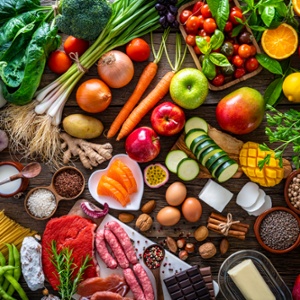The balance of what and how much we eat are important parts of achieving a healthy diet. Over recent year’s food and drink portion sizes have increased. From the things we buy in a supermarket to the meals we are given in cafes and restaurants. This has led to us all getting used to bigger portions, larger plates, and this being the normal size to eat. Because of this, many of us find it hard to recognise what portion sizes are right for us.
Eating bigger portions can mean you may struggle more with your weight if you eat more than your body needs. If portion sizes are something you struggle with, there are things you can do to help.
Portion size guide
The British Heart Foundation (BHF) suggests how many daily portions we need for each food group if we want to lose weight. Think about what you eat during the day and the portions you have. Is it similar, or do you think you might eat more than this? Look at the balance of the food groups too, and the recommended daily portions for each group.
Daily portions guide
Food group |
Daily portions (women) |
Daily portions (men) |
|---|---|---|
| Fruit and vegetables | 5 or more | 5 or more |
| Bread, rice, potatoes, pasta and other starchy foods | 7 | 8 |
| Milk and dairy foods | 3 | 3 |
| Meat, fish, eggs beans and other non-dairy sources of protein | 2 | 3 |
| Spreading fats and oils | 1 | 2 |
Credit: BHF Portion Size Guide
This visual hand guide will give you an idea of what these daily portions actually look like and could help you compare what you usually eat with these examples. Does this look similar to your portions sizes, or do you think you have more than this? Could you make a change to move towards these examples?
Visual portions guide
Credit: BHF Portion Size Guide
Interactive Food Portion Size Guide - British Heart Foundation
These portion size tools are a guide, and will vary depending on how active you are, your age and your gender. Over time and with practice, you will be able to recognise what portion sizes are appropriate for you whilst being able to recognise your hunger and fullness signals to guide you.
Practical tips
You can do a few quick and practical things to reduce your portions sizes too. You might find some of these ideas helpful:
- Use smaller plates and glasses at home.
- Think about the number of people eating and measure your food before cooking.
- Store leftovers in the fridge for the next day, or freeze them for a later date.
- Go for smaller sizes when ordering food and drink outside of the home, when you can.
- Talk to family and friends about your goals to help when eating and drinking at other people’s homes.
- Check the labels on prepared foods for the recommended portion sizes; sometimes this is a much smaller portion than the whole product.
Make a note of any changes you think you could make to your portion sizes and set yourself a portion size goal.






